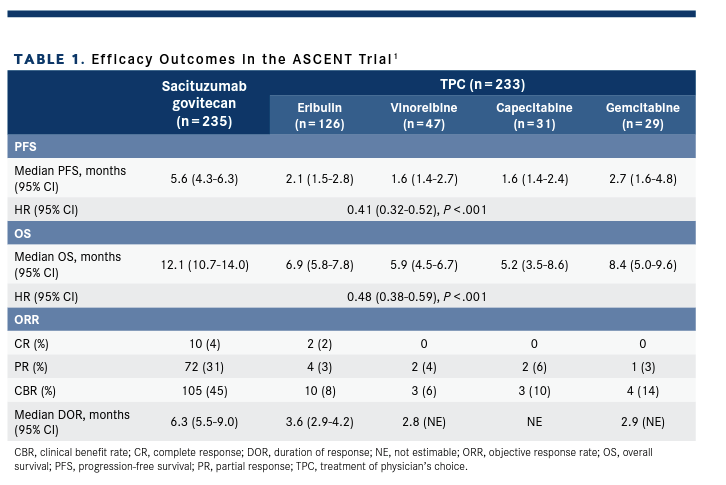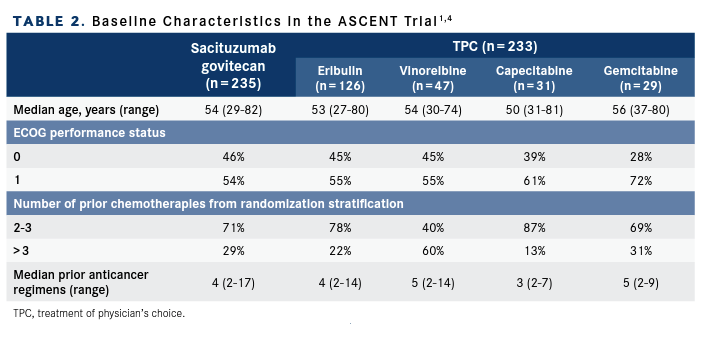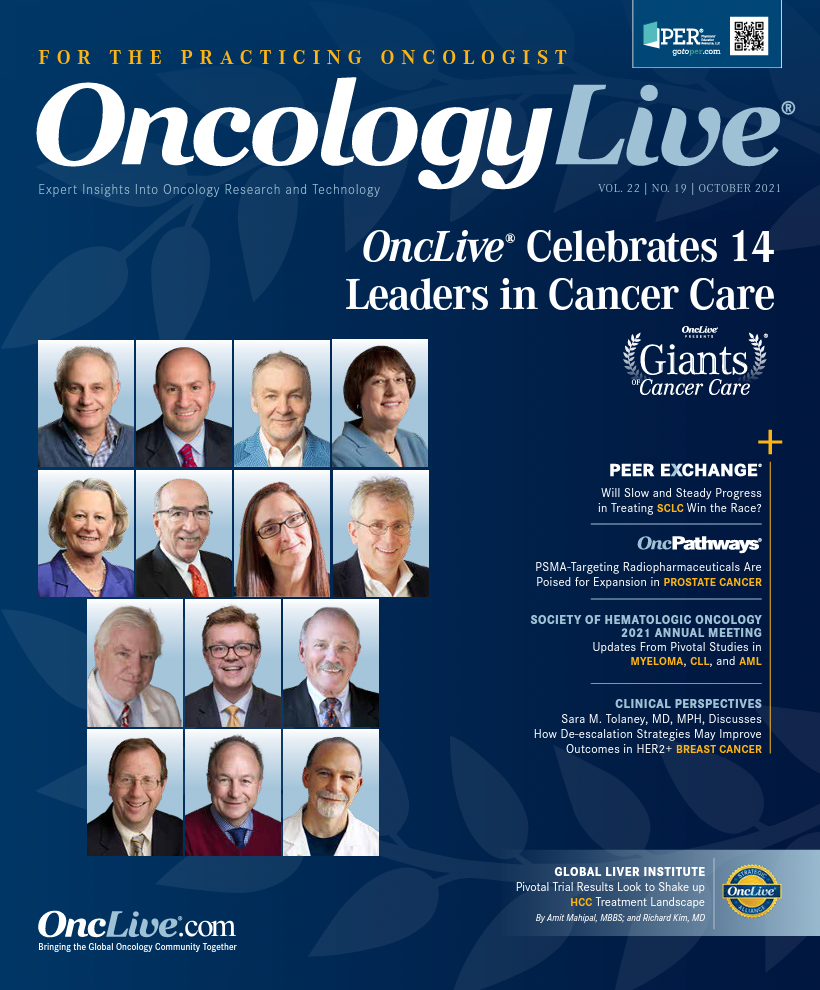Sacituzumab Govitecan May Be New Standard of Care in Metastatic TNBC
Hope S. Rugo, MD, FASCO, provides her insights on the final analysis data from the international phase 3 ASCENT trial.
Hope S. Rugo, MD, FASCO

Sacituzumab govitecan-hziy (Trodelvy) demonstrated a significant survival improvement over single-agent chemotherapy treatment of physician’s choice (TPC) for patients with metastatic triple-negative breast cancer (mTNBC), according to data presented by Hope S. Rugo, MD, FASCO.
As part of the OncLive® Rapid Readout video series, which features experts delving into key trial results presented at conferences, Rugo provided her insights on the final analysis data from the international phase 3 ASCENT trial (NCT02574455). The findings were initially presented at the 2021 American Society of Clinical Oncology Annual Meeting.1
In previously published findings, the novel antibody-drug conjugate (ADC) sacituzumab govitecan resulted in a median progression-free survival (PFS) of 5.6 months (95% CI, 4.3-6.3) vs 1.7 months (95% CI, 1.5-2.6 with single-agent TPC (HR, 0.41; 95% CI, 0.320.52; P < .001) among patients without brain metastases treated in the study. The median overall survival (OS) with sacituzumab govitecan was 12.1 months (95% CI, 10.7-14.0) vs 6.7 months (95% CI, 5.8-7.7) with single-agent TPC in the overall population (HR, 0.48; 95% CI, 0.38-0.59; P < .001).2
In a subanalysis of the ASCENT study, efficacy outcomes were assessed in the brain metastases–negative population for each individual chemotherapeutic agent. The investigators determined the singleagent chemotherapy before patients were randomized from one of the following choices: eribulin (n = 126), vinorelbine (n = 47), capecitabine (n = 31), or gemcitabine (n = 29).1
According to the subgroup analysis, gemcitabine had the longest median PFS at 2.7 months (95% CI, 1.6-4.8) vs the other single-agent TPCs. Specifically, the median PFS with eribulin was 2.1 months (95% CI, 1.5-2.8), 1.6 months (95% CI, 1.4-2.7) with vinorelbine, and 1.6 months (95% CI, 1.4-2.4) with capecitabine.
Further, gemcitabine elicited the longest median OS at 8.4 months (95% CI, 5.0-9.6), vs 6.9 months (95% CI, 5.8-7.8) with eribulin, 5.9 months (95% CI, 4.5-6.7) with vinorelbine, and 5.2 months (95% CI, 3.5-8.6) with capecitabine (Table 11). These data were reported in comparison with a median PFS of 5.6 months (HR, 0.41; 95% CI, 0.32-0.52; P < .001) and a median OS of 12.1 months with sacituzumab govitecan (HR, 0.48; 95% CI, 0.38-0.59; P < .001).
Table 1. Efficacy Outcomes in the ASCENT Trial1

“mTNBC is a disease that has had limited treatment options, and a number of chemotherapy agents are used in sequence,” said Rugo, a professor of medicine and director of Breast Oncology and Clinical Trials Education at the University of California San Francisco Helen Diller Family Comprehensive Cancer Center, and the 2020 Giants of Cancer Care® award winner in the Education category.
“Eribulin has been a commonly used monotherapy for previously treated mTNBC based on data from the EMBRACE trial [NCT00388726], but median PFS in heavily pretreated patients has been poor at less than 3 months.”
“[Sacituzumab govitecan] has become an early standard of care with rapid adoption throughout the United States, where we are treating patients with TNBC and have access to [the agent]. There is tremendous interest around the world for having as quick access to sacituzumab govitecan as possible.”
In April 2021, the FDA approved sacituzumab govitecan for patients with unresectable locally advanced or metastatic TNBC who have received at least 2 prior systemic therapies, with at least one of them for metastatic disease, based on findings from ASCENT. The agency previously granted an accelerated approval in April 2020 for patients with mTNBC who have received at least 2 prior therapies for metastatic disease; ASCENT was the confirmatory trial for the accelerated approval.3
Due to this heterogenous disease’s lack of therapeutic targets, mTNBC has been historically limited to single-agent chemo-therapy treatment options. Although this remains the standard of care for previously treated mTNBC, ADCs have made head-way as viable treatment options for this patient population.2
Pivotal Trial Details
Sacituzumab govitecan is an ADC that binds to Trop-2–expressing cancer cells. It is internalized with the subsequent release of SN-38 via hydrolysis of the linker, resulting in DNA damage that leads to apoptosis and cell death.4
In ASCENT, a multicenter, open-label, randomized trial, investigators enrolled 529 patients with unresectable locally advanced or mTNBC who had relapsed after at least 2 prior chemotherapies. One of those therapies could be in the neoadjuvant setting if progression occurred within 12 months. Of the total patient population, 235 and 233 patients were negative for brain metastasis in the sacituzumab govitecan and TPC arms, respectively.1,2
The median age was 54 years (range, 27-82). Forty-two percent of patients had hepatic metastases, 9% had BRCA1/BRCA2 mutations, and 70% had TNBC at diagnosis. Twelve percent had baseline previously treated and stable brain metastases (n = 61; 32 in the sacituzumab govitecan arm, 29 in the TPC arm). Overall, 29% of patients had received prior PD-1/PD-L1 therapy (Table 21,4).
Table 2. Baseline Characteristics in the ASCENT Trial1,4

Patients were randomized (1:1) to receive sacituzumab govitecan 10 mg as an intravenous infusion on days 1 and 8 of a 21-day cycle or a single-agent TPC. At the data cutoff of March 11, 2020, 15 patients (6%) remained on treatment in the sacituzumab govitecan arm and 0 patients remained on treatment in any TPC agent arm. The most common reason for treatment discontinuation was disease progression.1,2
Additional efficacy end points stratified in the subanalysis were objective response rates (ORRs) and clinical benefit rates (CBRs) for the ADC vs individual chemotherapy regimens. The ORR with sacituzumab govitecan was 35%, vs 5%, 4%, 6%, and 3% with eribulin, vinorelbine, capecitabine, or gemcitabine, respectively. Ten patients in the sacituzumab govitecan arm had a complete response vs 2 patients in the eribulin arm; no patients achieved a complete response in the other chemotherapy groups. The median duration of response for the sacituzumab govitecan group was 6.3 months and ranged from 2.8 to 3.6 months for the TPC groups.1
The CBR with sacituzumab govitecan was 45%, vs 8%, 6%, 10%, and 14% with eribulin, vinorelbine, capecitabine, or gemcitabine, respectively. CBR was defined as the percentage of patients with a confirmed best overall response of complete response or partial response, and stable disease greater than 6 months.
Thus, Rugo highlighted the fact that none of the agents individually tested in the TPC arm did not offered any significant outcomes when directly compared against sacituzumab govitecan.
“You can see the big separation and how similar the TPC arms fall in their [KaplanMeier] curves,” Rugo said. “[Also, ORR] was extremely low for the agents and they were all very similar so one did not stand out.”
Regarding safety, the investigators reported a number of grade 3/4 treatment-related adverse effects (AEs) observed in the safety population with sacituzumab govitecan (n = 258) vs eribulin (n = 123), respectively. These included neutropenia (51% vs 31%), leukopenia (10% vs 5%), diarrhea (10% vs 0%), anemia (8% vs 2%), febrile neutropenia (6% vs 2%), fatigue (3% vs 5%), and peripheral neuropathy (0% vs 2%).1
Additionally, grade 3/4 AEs with sacituzumab govitecan vs a pooled analysis of patients treated with vinorelbine, capecitabine, and gemcitabine (n = 101) included neutropenia (51% vs 36%), leukopenia (10% vs 6%), diarrhea (10% vs 1%), anemia (8% vs 8%), febrile neutropenia (6% vs 2%), and fatigue (3% vs 6%).
Discontinuation rates because of AEs for sacituzumab govitecan, eribulin, vinorelbine, capecitabine, and gemcitabine were 5%, 2%, 10%, 7%, and 9%, respectively. One treatment-related death was reported in the TPC arm (eribulin; neutropenic sepsis).1
“What we learned supports what we understood from the parent ASCENT trial and shows how effective sacituzumab govitecan is compared with TPCs, but it also gave us important additional information about safety management,” Rugo said. “The more we look at safety and think about prospective management of safety, the better we can help our patients stay on effective therapy and also retain quality of life.”
In an analysis of health-related quality-of-life (HRQOL) data presented at the European Society for Medical Oncology Annual Congress 2021, sacituzumab govitecan showed statistically significant and clinically meaningful improvements over TPC.5
Specifically, the agent prolonged time to first deterioration of in nearly all HRQOL domains and significantly shortened the time to improvement in physical functioning and pain.5 The median time to first clinically meaningful deterioration for physical functioning was 22.1 weeks with sacituzumab govitecan vs 12.1 weeks with TPC (HR, 0.61; 95% CI, 0.49-0.75). For pain the median time to deterioration was 21.6 weeks vs 9.9 weeks with TPC (HR, 0.48; 95% CI, 0.48-0.74).
The benefit extended to other HRQOL domains including fatigue and role functioning; however, the median time to deterioration in the global health status and quality of life domain for those treated with TPC at 15.1 weeks compared with 14.1 weeks with sacituzumab govitecan (HR, 0.87; 95% CI, 0.70-1.07).5
In her discussion of the subgroup analysis Rugo concluded that sacituzumab govitecan should be considered as a new standard of care in patients with pretreated mTNBC. She added that ongoing clinical trials are evaluating moving sacituzumab govitecan into the first-line setting as well as the postneoadjuvant and neoadjuvant settings.
“There are also clinical trials evaluating sacituzumab govitecan in combination with checkpoint inhibitors,” Rugo noted. “There’s great interest in capitalizing on those potential immune effects of ADCs [with] these combinations.”
References
- O’Shaughnessy J, Punie K, Oliveira M, et al. Assessment of sacituzumab govitecan (SG) versus treatment of physician’s choice (TPC) cohort by agent in the phase 3 ASCENT study of patients (pts) with metastatic triple-negative breast cancer (mTNBC). J Clin Oncol. 2021;39(suppl 15):1077. doi:10.1200/JCO.2021.39.15_suppl.1077
- Bardia A, Hurvitz SA, Tolaney SM, et al; ASCENT Clinical Trial Investigators. Sacituzumab govitecan in metastatic triple-negative breast cancer. N Engl J Med. 2021;384(16):1529-1541. doi:10.1056/NEJMoa2028485
- FDA grants regular approval to sacituzumab govitecan for triple-negative breast cancer. FDA. April 8, 2021. Accessed September 12, 2021. bit.ly/38tqmUM
- Trodelvy. Prescribing information. Immunomedics, Inc; 2021. Accessed September 12, 2021. bit.ly/2TBUCcl
- Loibl S, Loirat D, Tolaney S, et al. Health-related quality of life (HRQoL) in the ASCENT study of sacituzumab govitecan (SG) in metastatic triple-negative breast cancer (mTNBC). Presented at: European Society for Medical Oncology Annual Congress 2021. September 16-21, 2021; virtual. Abstract 257P.




